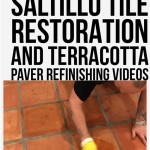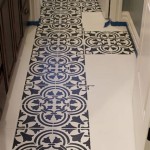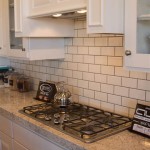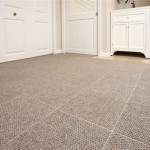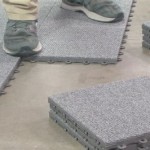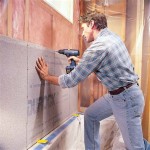How To Remove Tile Mortar From Concrete Floor
Removing tile mortar from a concrete floor is a common task encountered during renovation projects, especially when replacing old or damaged tiles. The process can be labor-intensive and potentially damaging to the underlying concrete if not performed correctly. This article provides a comprehensive guide on how to effectively and safely remove tile mortar, ensuring a clean and prepared surface for future flooring installations.
The methods used to remove the mortar will vary depending on the type of mortar, its age, and the condition of the concrete. Understanding these factors is crucial for selecting the most appropriate approach. Ignoring the correct methodology can lead to unnecessary damage to the concrete slab, requiring costly repairs. Therefore, careful consideration and preparation are essential before commencing the removal process.
Prior to initiating any removal efforts, adequate safety precautions must be taken. Mortar dust can be harmful if inhaled, and flying debris can cause eye injuries. Ensuring a safe working environment is paramount, protecting both the individual performing the work and any surrounding areas.
Preparation and Safety Measures
The initial step in removing tile mortar involves thorough preparation. This includes gathering the necessary tools and materials, protecting the surrounding area, and ensuring personal safety. Neglecting these preparatory steps can result in inefficient work, potential injuries, or damage to adjacent surfaces.
Firstly, collect the required tools. These may include a hammer, a chisel (or a specialized mortar removal chisel), a putty knife or scraper, a power scraper (optional), a wet/dry vacuum, a wire brush, safety glasses, a dust mask or respirator, work gloves, and knee pads. The specific tools needed will depend on the chosen removal method and the tenacity of the mortar.
Next, protect the surrounding area. Cover any nearby walls, furniture, or fixtures with plastic sheeting secured with painter's tape. This will prevent dust and debris from settling on these surfaces, minimizing cleanup efforts and preventing potential damage. It is also advisable to close off the work area from other parts of the house to contain the dust.
Personal safety is paramount. Always wear safety glasses to protect the eyes from flying debris. A dust mask or, preferably, a respirator is essential to prevent the inhalation of mortar dust, which can be harmful to the respiratory system. Work gloves will protect the hands from abrasions and potential cuts, while knee pads will provide comfort and support when working on the floor for extended periods.
Before beginning the physical removal process, thoroughly vacuum the floor to remove any loose debris, dirt, or dust. This will provide a cleaner working surface and improve visibility. It also reduces the amount of dust that will be stirred up during the removal process.
Manual Mortar Removal Techniques
Manual mortar removal is often the preferred method for smaller areas or when dealing with delicate concrete surfaces where power tools could cause damage. This approach relies on hand tools and physical effort to break down and remove the mortar. While more time-consuming than using power tools, it provides greater control and reduces the risk of damaging the concrete.
The primary tool for manual mortar removal is a chisel and hammer. Place the chisel at a low angle against the mortar, aiming to chip away small pieces at a time. Avoid striking the chisel too hard, as this can damage the concrete beneath. Focus on loosening the mortar gradually, working along the edges of the tile adhesive.
Specialized mortar removal chisels, often with a wider blade and angled design, can be particularly effective. These chisels are designed to remove mortar more efficiently while minimizing the risk of gouging the concrete. Experiment with different chisel angles and striking forces to find the most effective approach for the specific type of mortar being removed.
Once the mortar has been loosened with the chisel and hammer, a putty knife or scraper can be used to remove any remaining residue. Hold the scraper at a low angle and apply firm pressure to scrape away the mortar. A heat gun can be used to soften the mortar, making it easier to scrape away. Be sure to use caution when using a heat gun, as excessive heat can damage the concrete.
A wire brush can be used to scrub away any stubborn mortar residue. Choose a brush with stiff bristles that can effectively remove the mortar without damaging the concrete. Apply moderate pressure and scrub in a circular motion.
After each stage of the manual removal process, vacuum the floor thoroughly to remove any loose debris. This will provide a cleaner working surface and improve visibility, making it easier to identify areas that still require attention.
Power Tool Mortar Removal Techniques
For larger areas or more stubborn mortar, power tools can significantly speed up the removal process. However, it is crucial to use these tools with caution and proper technique to avoid damaging the concrete. Understanding the capabilities and limitations of each tool is essential for achieving the desired results.
A power scraper, also known as a floor scraper, is a specialized tool designed for removing tile mortar and other adhesive materials from concrete floors. It typically features a vibrating blade that efficiently breaks down the mortar. When using a power scraper, start with a low setting and gradually increase the power as needed. Maintain a consistent angle and pressure to prevent gouging the concrete. Overlapping passes will ensure that the entire surface is covered.
Another option is to use an angle grinder with a diamond grinding wheel or a mortar removal disk. These tools are very aggressive and can quickly remove mortar, but they also carry a higher risk of damaging the concrete. Use a light touch and avoid applying excessive pressure. Keep the grinder moving constantly to prevent overheating the grinding wheel or disk. A dust shroud attached to a vacuum can help to control the dust generated by the grinder.
A hammer drill with a chisel attachment can also be used to remove mortar. The hammering action of the drill helps to break down the mortar more efficiently than manual chiseling. Use a wide chisel attachment to cover more surface area with each pass. Avoid applying excessive pressure, as this can damage the concrete. Maintain a low angle and focus on removing small pieces of mortar at a time.
Regardless of the power tool used, it is essential to wear appropriate safety gear, including safety glasses, a respirator, and hearing protection. Power tools generate significant dust and noise, so protecting yourself from these hazards is crucial. Also, be mindful of the potential for vibration, which can cause fatigue and discomfort over extended periods.
After using power tools, thoroughly vacuum the floor to remove all dust and debris. Inspect the surface carefully for any gouges or damage to the concrete. If any damage is found, it may be necessary to repair the concrete before installing new flooring.
Following the removal of tile mortar from a concrete floor necessitates appropriate cleanup and surface preparation before any new flooring can be installed. The concrete surface must be clean, level, and free of any residual mortar or debris. Failure to properly prepare the surface can compromise the adhesion and longevity of the new flooring.
The initial step in cleanup is to thoroughly vacuum the entire area, ensuring that all dust, debris, and mortar fragments are removed. A wet/dry vacuum is ideal for this purpose, as it can handle both dry and wet materials. Pay particular attention to corners, edges, and any cracks or crevices in the concrete.
After vacuuming, scrub the concrete surface with a solution of water and a mild detergent. Use a stiff-bristled brush to scrub away any remaining residue or stains. Rinse the surface thoroughly with clean water and allow it to dry completely. A concrete cleaner or degreaser can be used for stubborn stains or grease. Always follow the manufacturer's instructions when using these products.
Inspect the concrete surface for any cracks, holes, or other imperfections. These should be repaired before installing new flooring. Small cracks can be filled with a concrete patching compound, while larger cracks or holes may require more extensive repairs. Follow the manufacturer's instructions for the patching compound or repair material. Allow the repaired areas to cure completely before proceeding.
For optimal adhesion of new flooring, the concrete surface should be properly primed. A concrete primer helps to seal the surface, improve adhesion, and prevent moisture migration. Choose a primer that is compatible with the type of flooring being installed. Apply the primer according to the manufacturer's instructions and allow it to dry completely before proceeding.
Finally, ensure that the concrete surface is level. Any significant unevenness can affect the appearance and performance of the new flooring. Use a self-leveling compound to correct any uneven areas. Follow the manufacturer's instructions carefully and allow the compound to dry completely before proceeding.

The Best Way To Remove Thinset From Concrete House Home

How To Remove Thinset All Removal Tools Surfaces

Remove Thinset From Concrete Floor Dust Free Amazing Result Step By

Removing Tile And Thinset From Concrete Sawdust Girl

The Best Way To Remove Thinset From A Cement Foundation House Of Hepworths

Removing Tile And Thinset From Concrete Sawdust Girl

How To Remove Thinset All Removal Tools Surfaces

The Best Way To Remove Thinset From A Cement Foundation House Of Hepworths

The Best Way To Remove Thinset From Concrete House Home

How To Remove Thinset All Removal Tools Surfaces
Related Posts

